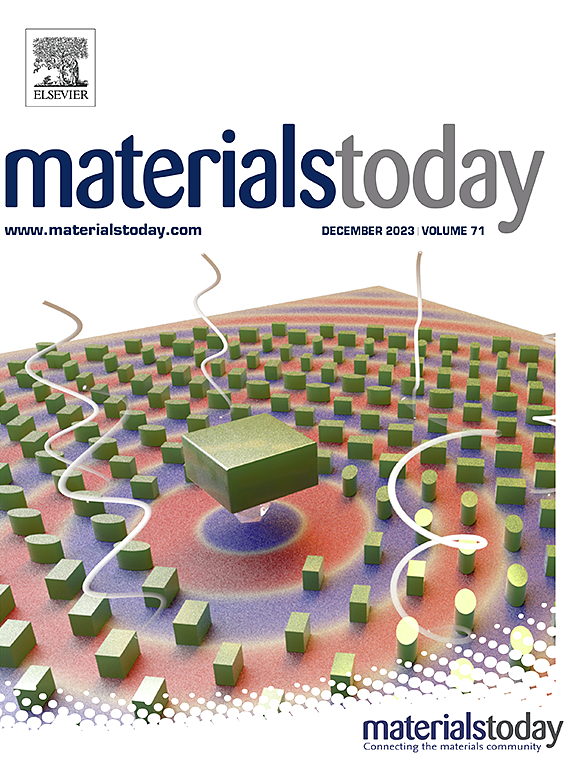Chemotherapeutics-enabled apoptosis-pyroptosis switch to trigger adaptive and innate immunity for metastatic breast cancer immunotherapy
IF 21.1
1区 材料科学
Q1 MATERIALS SCIENCE, MULTIDISCIPLINARY
引用次数: 0
Abstract
Pyroptosis-inducing chemotherapeutics hold promise for activating both adaptive and innate immunity in breast cancer immunotherapy. However, their practical efficacy is often limited by inadequate expression of pyroptosis-executed gasdermin and insufficient transfer of tumor-derived DNA. In this work, our findings indicated that the epigenetic drug of decitabine (DEC) can increase the gasdermin E (GSDME) level in breast cancer cells, while the DNA-damaging chemotherapeutic drug of 7-ethyl-10-hydroxycamptothecin (SN38) can activate caspase-3 and cyclic GMP-AMP synthase-stimulator of interferon gene (cGAS-STING) pathway. Based on these discoveries, a glutathione (GSH)-responsive nanoplatform equipped with PD-L1 blockade peptide (PD-L1 pep) is further fabricated for targeting delivery of these chemotherapeutic combination to breast cancer cells. Interestingly, the apoptosis-pyroptosis switch (denoted as PL@SD) not only enables the cascade activation of caspase-3 and GSDME to induce an apoptosis-pyroptosis transition, but also accelerates the release of tumor-derived DNA through the pore-formation to elicit the cGAS-STING activity. Concurrently, PL@SD elevates dendritic cell maturation, cytotoxic T lymphocyte infiltration, natural killer cell recruitment and long-term immunological memory effect to boost adaptive and innate immunity, thus synergistically suppressing primary breast cancer, distant lung metastases and tumor rechallenge. Overall, this study presents an elaborate strategy for apoptosis-pyroptosis transition and cGAS-STING activation, which might provide a new insight to expand the applications of the existing therapeutic drugs for tumor immunotherapy.

化疗启用凋亡-焦亡开关触发转移性乳腺癌免疫治疗的适应性和先天免疫
在乳腺癌免疫治疗中,诱导热疗的化疗药物有望激活适应性免疫和先天免疫。然而,它们的实际功效往往受到热致气真皮蛋白表达不足和肿瘤来源DNA转移不足的限制。本研究发现,表观遗传药物地西他滨(DEC)可增加乳腺癌细胞中气凝胶素E (GSDME)水平,而dna损伤化疗药物7-乙基-10-羟基喜树碱(SN38)可激活caspase-3和环GMP-AMP合成酶刺激因子干扰素基因(cGAS-STING)通路。基于这些发现,我们进一步构建了一个谷胱甘肽(GSH)响应的纳米平台,该平台配备了PD-L1阻断肽(PD-L1 pep),用于靶向递送这些化疗组合到乳腺癌细胞中。有趣的是,凋亡-焦亡开关(表示为PL@SD)不仅可以级联激活caspase-3和GSDME诱导凋亡-焦亡转变,还可以通过孔隙形成加速肿瘤源性DNA的释放,从而引发cGAS-STING活性。同时,PL@SD提高树突状细胞成熟、细胞毒性T淋巴细胞浸润、自然杀伤细胞募集和长期免疫记忆效应,增强适应性免疫和先天免疫,从而协同抑制原发性乳腺癌、远处肺转移和肿瘤再挑战。综上所述,本研究提出了凋亡-焦亡转化和cGAS-STING激活的精细策略,可能为扩大现有治疗药物在肿瘤免疫治疗中的应用提供新的见解。
本文章由计算机程序翻译,如有差异,请以英文原文为准。
求助全文
约1分钟内获得全文
求助全文
来源期刊

Materials Today
工程技术-材料科学:综合
CiteScore
36.30
自引率
1.20%
发文量
237
审稿时长
23 days
期刊介绍:
Materials Today is the leading journal in the Materials Today family, focusing on the latest and most impactful work in the materials science community. With a reputation for excellence in news and reviews, the journal has now expanded its coverage to include original research and aims to be at the forefront of the field.
We welcome comprehensive articles, short communications, and review articles from established leaders in the rapidly evolving fields of materials science and related disciplines. We strive to provide authors with rigorous peer review, fast publication, and maximum exposure for their work. While we only accept the most significant manuscripts, our speedy evaluation process ensures that there are no unnecessary publication delays.
 求助内容:
求助内容: 应助结果提醒方式:
应助结果提醒方式:


